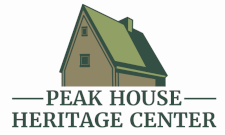Mission
Our Mission
To engage, inform, inspire visitors as they learn about this historic house, the events that occurred here, and the diverse residents who shaped its legacy.
What makes the Peak House unique?
Located at 347 Main Street (Route 109) in Medfield, its construction is one of the earliest surviving examples of post-medieval English (Elizabethan) architecture. It is also the only free-standing structure of its kind in the United States. A most striking feature is its exceptionally steep pitched roof, the highest on record in Massachusetts. This distinction is noted by its name, the Peak House.
Our First Period house has an innovational roof form, consisting entirely of principal rafters without purlins (a horizontal beam along the length of a roof, resting on a main rafter and supporting the common rafters or boards). According to Historic New England, this practice appeared in the growth of 17th century communities inland from the Massachusetts coast.
In 1924, with consultation by William Sumner Appleton from SPNEA (currently Historic New England), the Peak House was thoroughly restored without altering its basic framework. In 1975, it was accepted on the National Register of Historic Places as a privately-owned site.
The Peak House Heritage Center is created
In its quest to find a Peak House champion, the Medfield Historical Society’s Curators and Peak House Heritage Center’s Directors signed a ten-year Property Management Agreement in January 2019. This understanding gave autonomy to the Directors to manage the facility, operations, and visitor experiences while allowing the Society to retain the property’s deed.
What’s Our Legacy?
Family History – Since its construction by Benjamin Clark in 1711 for his son Seth, it became home to numerous Clark family generations until 1818 when non-family members began ownership. That trend continued until 1924 when Frederick Mason Smith deeded the house and property to the Medfield Historical Society.
Special Events – In 1854, Medfield’s first Catholic mass was celebrated here by James Griffin, a Peak House resident. In 1886, a studio was established on the second floor by John Jesse Francis, a landscape water colorist. Beginning in 1895, a carriage and chair painting business was conducted here by Frederick Mason Smith.
Horticulture – In 1986 the Medfield Garden Club planted award-winning herb gardens adjacent to it. After falling into neglect some years later, the gardens were restored in 2018.
Architecture – It occupies a very small frame: 24 feet long, 14 feet 10 inches wide, 10 feet from the ground to the eaves, and 12 feet from the top of the eaves to the roof top. The 4 exterior walls and the roof are covered with wood shingles. The 8 windows are furnished with restored casement sash, having diamond-shapes panes set in lead.
Archaeology – A dig immediately behind the house was conducted in 1976. Some of those artifacts are displayed in our current exhibits.
Cultural Tourism – It is one of the most recognizable sites in Medfield, located at the eastern end of Main Street (Route 109 is the second busiest undivided highway in Massachusetts).
What’s Our Impact?
Education – it enlightens visitors about the history of our community.
Reflection and Identity – it gives opportunities to residents and visitors to become directly involved, creates awareness, and develops pride in Medfield’s rich cultural heritage and history.
Economic Development – it draws tourists to Medfield for sustaining local businesses.
Community Support – it builds backing by hosting events and activities for Medfield residents and others.
